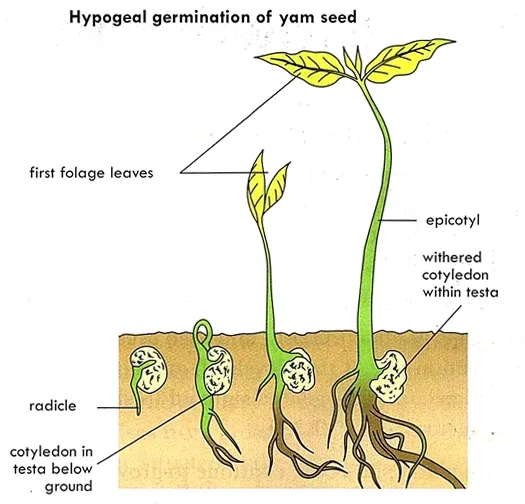Germination in Plants: The Birth of a New Plant
Germination
Germination is the process by which the embryo grows and develops, eventually becoming a fully mature plant. It is the onset growth of a seed, often following a period of dormancy or the emergence of embryo from the seed coat due to onset of growth and development of the seed. The pattern of germination is similar in most dicotyledonous seeds.
Mechanism of Seed Germination
During seed germination, seed absorbs water through the micropyle. The tissues absorb water and swell and the testa becomes soft. The radicle grows first, pushing though the testa and entering the soil. Next, either the hypocotyl or the epicotyl, depending on the species, starts to elongate and carry the plumule upwards through the soil.
Dormancy is the resting period in which growth stops temporarily and metabolism is reduced to its barest minimum. Dormant seed may survive adverse conditions such as drought, flood low and high temperature.
Stages of Germination
Germination involves several key stages:
Imbibition: The seed absorbs water, causing it to swell and break the seed coat. This initial step activates metabolic processes necessary for growth.
Activation of Metabolism: Enzymes and hormones are activated, breaking down stored food reserves in the endosperm or cotyledons. This provides energy and nutrients for the growing embryo.
Radicle Emergence: The embryonic root (radicle) emerges first, anchoring the seedling into the soil and beginning the process of water and nutrient uptake.
Shoot Emergence: The embryonic shoot (plumule) emerges, pushing upwards towards the light. This stage includes the development of the first true leaves.
Seedling Establishment: The seedling develops its root and shoot systems, establishing itself as an independent plant capable of photosynthesis and further growth.
- Learn more about the Stages of Germination on Britannica.
Conditions or Requirements for Germination
A viable seed can only germinate if the following environmental factors are available:
Water: seeds need a supply of water. This softens the testa or fruit wall and allows the radicle to grow and push its way out. Water activates the enzymes which convert the starch stored in the cotyledons or endosperm into soluble sugars which are then transported in solution to the growing regions.
Oxygen: Required for cellular respiration, which provides energy for the growing embryo.
Temperature: Optimal temperature ranges vary by species, but most seeds require moderate warmth to activate enzymes and support growth.
Light: Some seeds require light to germinate (photoblastic seeds), while others do not. Light can influence the direction and growth rate of the emerging shoot.
Nutrients: While the seed contains initial food reserves, soil nutrients become important once the seedling begins to establish itself.
- Read about the Requirements for Germination on ScienceDirect.
Types of Germination
1. Epigeal – type of germination where the cotyledon appears above the ground. It causes by elongation of the hypocotyl of the radicle. E.g., groundnut, cowpea, castor oil.
Whichever pattern of germination occurs, the energy and raw materials required for growth come from the food (usually starch) stored in the cotyledon.
- Explore different Types of Germination on Frontiers in Plant Science.
Differences between epigeal and hypogeal germination
Epigeal germination | Hypogeal germination |
Testa split | Pericarp split |
Hypocotyl emerges uncovered | Hypocotyl covered by the sheath/coleorhiza |
Cotyledons are carried above the soil | Cotyledons remain in the soil |
Hypocotyl elongates | Epicotyl elongate/straightens out |
Cotyledon is the first photosynthetic tissue until true foliage leaves develops | Cotyledons wither so true foliage leaves are first photosynthetic tissue |
Energy obtained from food stored in the cotyledon | Energy obtained from food stored in the endosperm |
 |
| Hypogeal germination of seed |
Significance of Germination
Plant Propagation: Germination is the first step in plant propagation, allowing plants to reproduce and spread.
Agricultural Productivity: Successful germination is crucial for crop production. Understanding germination can help improve agricultural practices and yields.
Ecological Balance: Germination contributes to the maintenance of plant populations and biodiversity in ecosystems.
Seedling Establishment: Germination ensures that the new plant can establish itself and grow independently, starting the life cycle anew.
- Discover the Importance of Germination on National Geographic.
Conclusion
Germination is a complex and vital process that marks the beginning of a seed's transformation into a new plant. Understanding the stages, requirements, types, and significance of germination provides valuable insights into plant biology and ecology. This knowledge is essential for agriculture, horticulture, and conservation efforts, ensuring successful plant propagation and growth.
For further reading, visit Germination on Britannica and Importance of Germination on National Geographic.
Related Post on Biology Topics
- Morphology Of Monocotyledonous and Dicotyledonous Plants
- Internal Structures of Plant Roots, Stems and Leaves
- Growth and Development of Plants
- Photosynthesis and Mineral Nutrition
- Gaseous Exchange in Plants
- Transport in Plants
- Reproduction in Plants
- Germination in Plants


